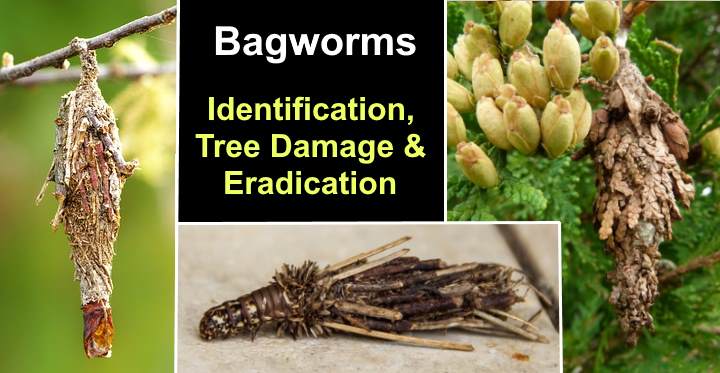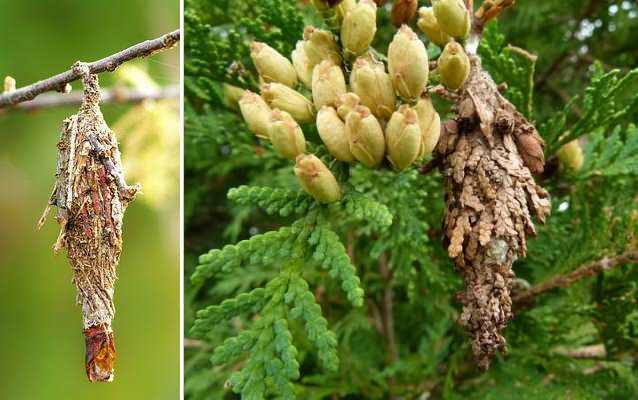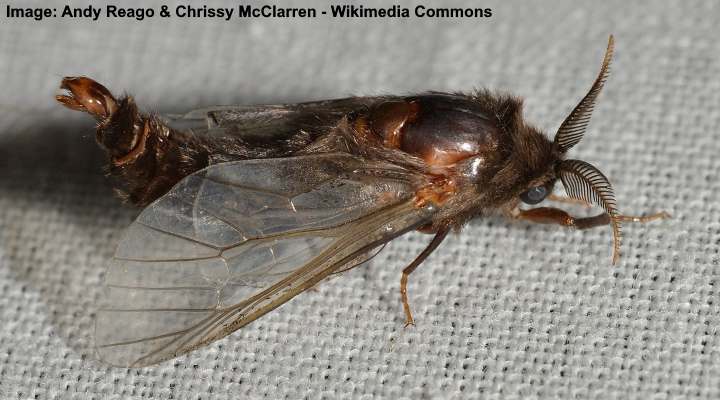Bagworms: Identification, Tree Damage, Eradication (With Pictures of Evergreen Bagworms)

Bagworms are destructive garden pests that attack evergreen and deciduous trees. Commonly called evergreen bagworms, the tiny larvae are voracious feeders that can strip trees of foliage and even kill them. Bagworms are tricky to spot. The tiny brown or black caterpillars live in cocoons that look like seed cones dangling on evergreen trees. The most effective way to get rid of bagworms is to remove their bags from the trees and destroy the worms.
Evergreen bagworms turn into black furry moths after the pupal stage. Before you see the bagworm moths appear in the fall, the destruction has already happened.
Bagworms tend to infest evergreens such as arborvitae, junipers, cedars, and spruce trees. However, bagworms will also decimate deciduous trees such as maple, willow, poplar, and oak. Bagworms can infest up to 130 different species of trees and shrubs.
In this article, you will learn about the damage bagworms can do. You’ll also find out how to identify these plant-destroying worms and the cocoons they inhabit. At the end of the article, you can read about natural ways of getting rid of evergreen bagworms.
How to Get Rid of Evergreen Bagworms on Trees
Getting rid of bagworms from cypress, junipers, pine, and deciduous trees requires getting to know their lifecycle. In some cases, using pesticides or insecticides is necessary to eradicate the leaf-munching pests.
Here are a few ways of ridding trees of bagworm and their nests:
- Get rid of bagworms by removing their cocoons by hand. In summer, check trees for dangling cone-like cocoons about one inch (2.5 cm) long and remove them by hand. Drop them in soapy water to kill the bagworms for good.
- Use biological insecticides to kill evergreen bagworms. Use a natural biological insecticide such as Bacillus thuringiensis var. kurstaki and apply when larvae are immature.
- Introduce parasitic wasps that effectively kill off young bagworm larvae.
- Use neem oil spray to treat and control bagworms. Use a natural neem oil pesticide and apply it to affected trees before larvae are more than 1” (2.5 cm) long.
What Are Bagworms
Bagworms are the larval stage of certain moth species that damage evergreen and deciduous trees. The scientific name for bagworms is Thyridopteryx ephemeraeformis. Bagworms belong to the flying insect species Psychidae, and there are around 1,300 species of bagworms.
The name bagworm comes from the fact that the worm-like larvae emerge from bags. These moth caterpillars go by the names eastern bagworm, North American bagworm, or common basket worm.
Bagworms are typically tricky to spot because the glossy black larvae are only 0.04” (1 mm) when they start feeding. The newly hatched larvae almost immediately start spinning their own bag. Mature evergreen bagworm caterpillars can grow up to 1” (2.5 cm) in length.
Bagworm moths are furry black or dark brown moths with transparent wings. Only the male bagworm moths are seen flying in the fall because the females stay in the bag-like cocoons and fill them with eggs.
What Do Bagworms Look Like?

Bagworm larvae carry around their cocoon
Bagworms look like shiny dark or black caterpillars that grow up to 1” (2.5 cm) long. The black worm-like insects have a segmented body and an amber-colored, translucent head. When evergreen bagworms emerge from their bags or cocoons in late spring and early summer, they are only a few millimeters long.
Bagworms are tricky to spot on evergreen trees. The larvae tend to stay in their protective cocoon bags and only come out to feed. The black caterpillars also carry around their bags when they are feeding on various parts of the tree.
The most common sign of a bagworm infestation is their cone-like bags (cocoons) dangling from evergreen or deciduous trees. Even then, it’s tricky to recognize bagworms because they make camouflaged bags by spinning silk and using foliage from the tree.
Bagworm Cocoon

Bagworm cocoons (‘bags’) dangling from trees
Bagworm cocoons are the nests where the caterpillars live. Each bagworm spins its own cocoon nest, where it spends most of its life. The bagworm nest is made of silk, twigs, and bits of leaves. Bags of mature larvae are up to 2” (5 cm) long and 0.5” (1.2 cm) wide.
A bagworm cocoon looks like a large, long pointed pine cone. The center of the bagworm nest is the widest part, and it tapers to a point at either end, making it look like a spindle. The size of the cocoon grows as the black worm-like caterpillars add more foliage to the nest.
Cocoons dangling on evergreen and deciduous trees are usually their largest in late summer. This is the time when larvae are mature and enter the pupal stage.
Bagworm nests look different depending on the tree. For example, bagworm cocoons on pine trees will have parts of pine needles and twigs and look like pine cones. Bagworm cocoons on arborvitae will look like a clump of soft feathery needles dangling from branches.
Bagworms are unique types of crawling insects because they are the only caterpillars to incorporate plant foliage into their cocoons.
Bagworm Damage
Bagworms damage trees and shrubs in several ways. Bagworm infestations can defoliate trees, making them look unsightly and bare. Bagworms also spin strong silk around branches that firmly attach cocoons to the tree. In time, this can cause the twigs to die off.
The first sign of bagworm damage on deciduous and evergreen trees is unhealthy brown branch tips. As the bagworms grow, their appetite increases and they start devouring foliage. If not treated, bagworm infestations can completely strip a tree off its leaves.
Bagworm caterpillars are often called evergreen bagworms. This is because they cause the most significant damage to juniper species (Juniperus) and arborvitae trees (Thuja). Because evergreens don’t replace foliage as fast as deciduous trees, evergreen trees suffer the most damage. A defoliated conifer tree usually ends up dying.
It is not uncommon to see localized bagworm infestation on certain trees. Bagworms tend to feed near the mother’s host plant. This means that a large bagworm infestation of evergreens and shrubs can occur within a few meters. Also, it’s not uncommon for the same evergreens to be affected year after year.
The best way to protect trees from damage is to pick off bagworm cocoons by hand in the fall. Try to remove as many of the cone-like cocoon nests from affected trees as possible. This prevents hundreds or even thousands of bagworm eggs from hatching the following spring.
Bagworm Life Cycle
A bagworm starts life as an egg in the cocoon nest and goes through four stages (instars) to reach maturity. A female bagworm lays up to 1,000 eggs in the cocoon in late summer and fall. The eggs overwinter in the safety of the dangling bagworm nest. In late spring, the bagworm larvae hatch and leave the nest.
The wind usually disperses tiny bagworm larvae on their silken threads. The larvae start feeding ravenously on the same plant or a new host plant. During this time, the bagworm caterpillars construct their own bags. As they feed on the plant’s foliage, the worms expand the size of the bag using twigs and leaf bits from the tree.
Bagworm caterpillars stay in the dangling bags and move them to other parts of the tree to continue feeding. The plump bagworm protrudes its head and part of the body from the bag to move around a tree.
Late summer, the mature bagworm caterpillar firmly attaches the large bag to a branch in preparation for pupation. The bag is then sealed where the bagworm enters the pupal stage. Adult males transform into black moths, and the females that emerge are wingless, without legs and still look like a caterpillar.

Bagworm moth
Male bagworm moths then fly to seek out a female for mating. The female then lays eggs in the bag-like cocoon and usually dies. The bagworm lifecycle starts over again.
How to Identify Evergreen Bagworms on Trees
In late fall, bagworms are identified by the brown hanging cone-like bags on trees. Because these contain hundreds of bagworm eggs, the best time to remove the worms is in fall or winter. The brown sac-like cocoons are easy to spot against evergreen foliage.
Emerging, newly hatched larvae only measure 1 – 2 mm and are virtually impossible to spot. Only when small cone-like growths appear on trees are they easily identifiable. As the worms gorge on foliage, they use some of it to increase the size of their bags. This results in cone-like structures made from the same foliage of the host plant.
Individual bagworms are challenging to spot on trees. Their best defense is the camouflage bags that they stay in throughout their lifecycle. Extra vigilance is necessary to identify bagworms because their bags look like naturally growing parts of the tree.
Where Do Bagworms Come From?
Bagworms are generally found on evergreen and deciduous trees in the Eastern United States. You’ll find the tree-destroying caterpillars in most states east of the Mississippi River.
In urban environments, bagworms typically come from nearby infested trees or shrubs. After the eggs hatch, they fall from the hanging nests, and the wind carries them to nearby trees and plants. Some larvae also drop to the ground and crawl to a new host plant.
What Do Bagworms Eat?
Like most moth caterpillars, bagworms gorge on plant matter. A bagworm diet consists of leaves and tree buds. Red cedar (Juniperus virginiana) and arborvitae (Thuja) are the types of trees that the ‘bugs’ tend to feed on. However, bagworms also eat foliage from oak, sycamore, willow, poplar, birch, elm, cypress, pine, and spruce trees.
How to Get Rid of Bagworms on Trees such as Evergreens and Arborvitae
Getting rid of bagworms can be challenging. The best success to eradicate bagworms from evergreen or deciduous trees is to disrupt their lifecycle. Bagworms overwinter in their furry-looking bags hanging from branches. During this time, the eggs are dormant.
Usually, between October and March is the best time to remove all signs of bagworms from trees. It’s enough to cut the evergreen bagworm cocoons from the trees and drop them in hot, soapy water to kill off the eggs.
Typically, summer is the worst time to start trying to control bagworm populations.
How to Kill Evergreen Bagworms
Intervention, when bagworms are dormant, is the best way to keep bagworm numbers down. To ensure and eradicate bagworms from your yard, it’s crucial to have an integrated pest management system. This involves using various methods, including handpicking, biological insecticides, and natural controls.
Here are some methods that might be effective in getting rid of bagworms so that they never return.
Handpick Evergreen Bagworms to Remove them From Trees
Handpicking bagworms and destroying them is the best way to get rid of them for good. You should use a sharp knife to cut down the dangling cone-like cocoons and remove all the silk from branches. Place the bags in hot soapy water to kill all the eggs and larvae in the cocoon.
To identify the bagworm nests, look for brown or tan-colored cone-like growths dangling from trees. On evergreen trees, the bagworms may look like pine seed cones. On deciduous trees, the bagworms look like unusual, dried leafy growths drooping from branches.
Use Spinosad to Kill Evergreen Bagworms
One way to kill bagworms is to spray the caterpillars with a Spinosad. Spinosad is a naturally occurring soil bacterium toxic to caterpillars. You can buy natural commercial products containing Spinosad. Mix to the manufacturer’s instructions and spray all the tree’s foliage to kill bagworms. Repeat every seven days if necessary.
It’s good to note that Spinosad can be toxic to pollinators such as honeybees. Therefore, it’s best to use the natural insecticide in the early morning or late evening when bees are less active. Also, avoid treating affected trees during windy days or when rain is expected.
Some scientific studies suggest that Spinosad solutions can be effective against bagworms. One study indicated that applying the soil bacterium reduces the feeding rate and growth of larvae and helps to protect arborvitae foliage against bagworm damage.
Eradicate Evergreen Bagworms with Bacillus Thuringiensis
Spray evergreen trees with Bacillus thuringiensis var. Kurstaki to eradicate bagworm larvae from plants. Bacillus thuringiensis (Bt) is a soil microbe that is toxic to larvae. Bt works when the crawling caterpillars ingest plant matter that has the microbe. The bacterium poisons the larvae, resulting in their death.
The best time to apply Bacillus thuringiensis is in late spring when the eggs are hatching. Use every seven to 14 days to ensure that bagworms don’t destroy your evergreen tree or defoliate deciduous trees.
Parasitic Wasps Can Help to Control Evergreen Bagworms
One type of biological control method for bagworms is to use parasitic wasps. These tiny flying insects lay eggs inside caterpillars and reproduce inside them, thus killing them. You can use parasitic wasps as part of an integrated pest management system to control bagworm populations.
Researchers from the Illinois Natural History Survey say that three species of parasitoid wasps are effective for bagworm control: Pimpla disparis, Itoplectis conquisitor, and Gambrus ultimus
Use Neem Oil Spray to Kill Evergreen Bagworms
Neem oil sprays can help eradicate bagworms when used with other pest management strategies. Neem oil contains Azadirachtin—a natural pesticide that doesn’t harm beneficial insects.
Make a homemade bagworm spray by mixing 2.5 tablespoons of neem oil and 1 tablespoon of liquid dish soap for every gallon (4 l) of water. In summer, when the bagworm larvae have hatched, liberally spray evergreen foliage every seven days to get rid of bagworms.
In cases of severe bagworm infestations, natural control methods may not be sufficient to control bagworms. Therefore, it may be necessary to use commercial insecticides for bagworms to protect your evergreen and deciduous trees from damage.
Related articles:
